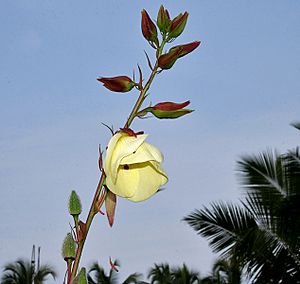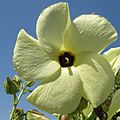Abelmoschus manihot facts for kids
Quick facts for kids Abelmoschus manihot |
|
|---|---|
 |
|
| Scientific classification | |
| Genus: |
Abelmoschus
|
| Species: |
manihot
|
| Synonyms | |
|
List
|
|
Aibika, also known as sunset muskmallow or sunset hibiscus, is a beautiful flowering plant. It belongs to the Malvaceae family, which also includes cotton and hibiscus. This plant used to be called a type of Hibiscus. But now, scientists have placed it in its own group called Abelmoschus.
Contents
Uses of Aibika
Aibika is a very useful plant in many parts of the world. People use different parts of it for food and even to make paper.
Aibika as a Vegetable
In the Philippines, aibika has many local names. Some of these names are lagikway, likway, and gikway. People there eat its leaves and young shoots. They are cooked like other leafy greens, similar to saluyot (Corchorus olitorius).
Aibika leaves are often added to popular Filipino dishes. These include tinola, a chicken soup, and sinigang, a sour soup. They are also used in pinangat, a dish with fish cooked in coconut milk. Sometimes, the fresh leaves are simply eaten in salads.
Aibika in Paper Making
Aibika is also important for making traditional paper. In Japan, this plant is called tororo aoi. A special starchy substance called neri is made from it. This neri is a key ingredient in making washi, which is traditional Japanese paper.
Similarly, in Korea, the plant is known as hwang chok kyu. It is used to create dak pul. This substance helps in making hanji, which is traditional Korean paper.
Aibika's Nutrition and Growth
Aibika is a very healthy plant to eat. It is also easy to grow and can provide food for a long time.
Nutritional Benefits
Even though it looks like a shrub, aibika is a perennial plant. This means it can live for many years. Under good conditions, it can grow taller than three meters. Aibika is known to be a very nutritious vegetable.
Its leaves are packed with important vitamins. They have a lot of Vitamin A and Vitamin C. They are also a good source of iron. About 12% of the dry weight of the leaves is protein. This makes aibika a great food source.
Growing Aibika
Aibika is quite easy to grow. You can start new plants from cuttings, which are small pieces of the plant. It does not get sick very often, so it is strong against diseases. People even believe it has some medicinal value.
Because it is so easy to grow and healthy, aibika is planted widely. You can often see it along the edges of gardens. It is also grown between other crops in many traditional gardens in warm, tropical areas.
See also
 In Spanish: Aibika para niños
In Spanish: Aibika para niños


